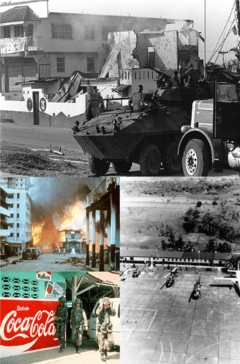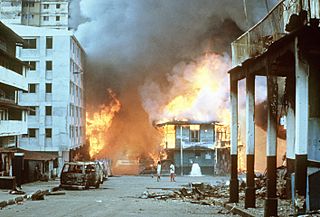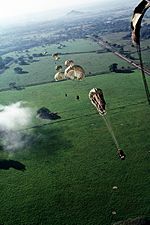United States invasion of Panama facts for kids
Quick facts for kids United States Invasion of Panama |
|||||||
|---|---|---|---|---|---|---|---|
| Part of the War on Drugs and the Cold War | |||||||
 Clockwise from top:
|
|||||||
|
|||||||
| Belligerents | |||||||
| Commanders and leaders | |||||||
| Strength | |||||||
| 16,000 | 27,000 | ||||||
| Casualties and losses | |||||||
| 314 killed 1,908 captured |
23 killed 325 wounded |
||||||
|
Panamanian civilians killed according to: |
|||||||
The United States Invasion of Panama, codenamed Operation Just Cause, lasted over a month between mid-December 1989 and late January 1990. It occurred during the administration of President George H. W. Bush and ten years after the Torrijos–Carter Treaties were ratified to transfer control of the Panama Canal from the United States to Panama by January 1, 2000. The primary purpose of the invasion was to depose the de facto Panamanian leader, General Manuel Noriega. Following the operation, the Panama Defense Forces were dissolved and President-elect Guillermo Endara was sworn into office. The United Nations General Assembly and the Organization of American States condemned the invasion as a violation of international law.
Contents
Background
The United States had maintained numerous military bases and a substantial garrison throughout the Canal Zone to protect the American-owned Panama Canal and to maintain American control of this strategically important area. On September 7, 1977, U.S. President Jimmy Carter and the de facto leader of Panama, General Omar Torrijos, signed the Torrijos–Carter Treaties, which set in motion the process of handing over the Panama Canal to Panamanian control by 2000. Although the canal was destined for Panamanian administration, the military bases remained and one condition of the transfer was that the canal would remain open for American shipping. The U.S. had long-standing relations with General Noriega, who served as a U.S. intelligence asset and paid informant of the Central Intelligence Agency from 1967, including the period when Bush was head of the CIA (1976–77).
Noriega had sided with the U.S. rather than the USSR in Central America, notably in sabotaging the forces of the Sandinista government in Nicaragua, and the revolutionaries of the FMLN group in El Salvador. Noriega received upwards of $100,000 per year from the 1960s until the 1980s, when his salary was increased to $200,000 per year.
In the mid-1980s, relations between Noriega and the United States began to deteriorate. In 1986, U.S. President Ronald Reagan opened negotiations with General Noriega, requesting that the Panamanian leader step down after he was publicly exposed in The New York Times by Seymour Hersh, and was later implicated in the Iran-Contra Scandal. However, Noriega did not submit to Reagan's demands. In 1988, Elliot Abrams and others in the Pentagon began pushing for a U.S. invasion, but Reagan refused. In March 1988, Noriega's forces resisted an attempted coup against the government of Panama. As relations continued to deteriorate, Noriega appeared to shift his Cold War allegiance towards the Soviet bloc, soliciting and receiving military aid from Cuba, Nicaragua, and Libya. American military planners began preparing contingency plans to invade Panama.
In May 1989, during the Panamanian national elections, an alliance of parties opposed to the Noriega dictatorship counted results from the country's election precincts, before they were sent to the district centers. Their tally showed their candidate, Guillermo Endara, defeating Carlos Duque, candidate of a pro-Noriega coalition, by nearly 3–1. Endara was physically assaulted by Noriega supporters the next day in his motorcade. Noriega declared the election null and maintained power by force, making him unpopular among Panamanians. Noriega's government insisted that it had won the presidential election and that irregularities had been on the part of U.S.-backed candidates from opposition parties. Bush called on Noriega to honor the will of the Panamanian people. The United States reinforced its Canal Zone garrison, and increased the tempo of training and other activities intended to put pressure on Noriega.
In October 1989, Noriega foiled a second coup attempt by members of the Panamanian Defense Forces (PDF), led by Major Moisés Giroldi. Pressure mounted on Bush. Bush declared that the U.S. would not negotiate with Noriega. On December 15, the Panamanian general assembly passed a resolution declaring that a state of war existed between Panama and the United States.
International mediation
Several neighboring governments secretly tried to negotiate a peaceful outcome and Noriega's willing resignation. Presidents Oscar Arias and Daniel Oduber of Costa Rica, Carlos Andrés Pérez of Venezuela, Alfonso López Michelsen of Colombia and Spanish Prime Minister Felipe González all on different occasions met Noriega in secret attempting to convince him to leave power and self-exile himself in Spain, to no avail.
U.S. rationale for the invasion
The official U.S. rationale for the invasion was articulated by President George H. W. Bush on the morning of December 20, 1989, a few hours after the start of the operation. Bush cited Panama's declaration of a state of war with the United States and attacks on U.S. troops as justification for the invasion.
Bush further identified four objectives of the invasion:
- Safeguarding the lives of U.S. citizens in Panama.
- Defending democracy and human rights in Panama.
- Combating drug trafficking.
- Protecting the integrity of the Torrijos–Carter Treaties. Members of Congress and others in the U.S. political establishment claimed that Noriega threatened the neutrality of the Panama Canal and that the U.S. had the right under the treaties to intervene militarily to protect the canal.
Bush's four reasons for the invasion provided sufficient justification to establish bipartisan Congressional approval and support for the invasion. However, the secrecy before initiation, the speed and success of the invasion itself, and U.S. public support for it (80% public approval) did not allow Democrats to object to Bush's decision to use military force. One contemporary study suggests that Bush decided to invade for domestic political reasons, citing scarce strategic reasoning for the U.S. to invade and immediately withdraw without establishing the structure to enforce the interests that Bush used to justify the invasion.
Military operations
The military incursion into Panama began on December 20, 1989, at 1:00 a.m. local time. The operation involved 27,684 U.S. troops and over 300 aircraft.
The operation began with an assault of strategic installations, such as the civilian Punta Paitilla Airport in Panama City and a PDF garrison and airfield at Rio Hato, where Noriega also maintained a residence. U.S. Navy SEALs destroyed Noriega's private jet and a Panamanian gunboat. Military command centers throughout the country were also attacked.
Fort Amador was secured by elements of the 1st Battalion (Airborne), 508th Parachute Infantry Regiment, 5th Infantry Division [Scouts] and 59th Engineer Company (sappers) in a nighttime air assault which secured the fort in the early hours of December 20. Fort Amador was a key position because of its relationship to the large oil farms adjacent to the canal, the Bridge of the Americas over the canal, and the Pacific entrance to the Panama Canal. Key command and control elements of the PDF were stationed there. C Company 1st Battalion (Airborne) 508th PIR was assigned the task of securing La Comandancia. Furthermore, Fort Amador had a large U.S. housing district that needed to be secured to prevent the PDF from taking U.S. citizens as hostages. This position also protected the left flank of the attack on La Comandancia and the securing of the El Chorrillos neighborhood, guarded by Dignity Battalions, Noriega supporters that the U.S. forces sometimes referred to as "Dingbats". Military police units from Ft. Bragg, North Carolina deployed via strategic airlift into Howard Air Force Base the next morning and secured key government buildings in the downtown area of Panama City. MPs seized PDF weapons, vehicles and supplies during house-to-house searches in the following days, and conducted urban combat operations against snipers and Dignity Battalion holdouts for the following week.
A few hours after the invasion began, Guillermo Endara was sworn in at Fort Clayton. According to The Los Angeles Times, Endara was the "presumed winner" in the presidential election which had been scheduled earlier that year.
A platoon from the 1138th Military Police Company, Missouri Army National Guard, which was on a routine two-week rotation to Panama was called upon to set up a detainee camp on Empire Range to handle the mass of civilian and military detainees. This unit was the first National Guard unit called into active service since the Vietnam War.
Noriega's capture
Operation Nifty Package was an operation launched by Navy SEALs to prevent Noriega's escape. They sank Noriega's boat and destroyed his jet. Military operations continued for several weeks, mainly against military units of the Panamanian army. Noriega remained at large for several days, but realizing he had few options in the face of a massive manhunt and a $1 million reward for his capture, he obtained refuge in the Vatican diplomatic mission in Panama City. The U.S. military's psychological pressure on him and diplomatic pressure on the Vatican mission, however, was relentless. Noriega finally surrendered to the U.S. military on January 3, 1990. He was immediately put on an MC-130E Combat Talon I aircraft and flown to the U.S.
Aftermath

Guillermo Endara, in hiding, was sworn in as president by a judge on the night preceding the invasion. In later years, he staged a hunger strike, calling attention to the poverty and homelessness left in the wake of both the Noriega years and the destruction caused by the U.S. invasion.
On July 19, 1990, a group of 60 companies with operations in Panama filed a lawsuit against the U.S. government in Federal District Court in New York City alleging that the U.S. action against Panama was "done in a tortuous, careless and negligent manner with disregard for the property of innocent Panamanian residents". Most of the businesses had insurance, but the insurers either went bankrupt or refused to pay, claiming that acts of war were not covered.
About 20,000 people lost their homes and became refugees as a result of urban warfare. About 2,700 families that were displaced by the Chorrillo fire were each given $6,500 by the U.S. to build a new house or apartment in selected areas in or near the city. However, numerous problems were reported with the new constructions just two years after the invasion.
The government of Guillermo Endara designated the first anniversary of the U.S. invasion a "national day of reflection". Hundreds of Panamanians marked the day with a "black march" through the streets of Panama City to denounce the U.S. invasion and Endara's economic policies. Protesters echoed claims that 3,000 people were killed as a result of U.S. military action. Since Noriega's ousting, Panama has had four presidential elections, with candidates from opposing parties succeeding each other in the Palacio de las Garzas. Panama's press, however, is still subject to numerous restrictions. On February 10, 1990, the Endara government abolished Panama's military and reformed the security apparatus by creating the Panamanian Public Forces. In 1994, a constitutional amendment permanently abolished the military of Panama. Concurrent with a severe recession in Latin America throughout the 1990s, Panama's GDP recovered by 1993, but very high unemployment remained a serious problem.
Noriega was brought to the U.S. to stand trial. He was sentenced to 40 years in prison. His sentence was later reduced to 30 years.
Related operations
- Operation Nifty Package: an operation which the SEALs undertook in order to capture Manuel Noriega or destroy his two escape routes, his private jet which was located at the Paitilla Airfield was destroyed in the operation along with his gunboat, which was docked in a canal. Noriega surrendered to U.S. troops on January 3, 1990.
- Operation Nimrod Dancer: an operation which reinforced the forward-deployed U.S. forces with a brigade headquarters and an infantry battalion task force from the 7th Inf Div (L), a mechanized infantry battalion from the 5th Inf Div (M), and a U.S. Marine Corps Light Armored Infantry (LAI) Company. Augmentation continued with units rotating from both divisions under Operation Nimrod Sustain.
- Operation Prayer Book
- Operation Promote Liberty: an operation whose purpose was to rebuild the Panamanian military and Panama's civilian infrastructure.
- Operation Purple Storm: an operation whose purpose was to assert, display, and exercise U.S. freedom-of-movement rights, with convoys traveling both inside and outside Panama for that express purpose.
- Operation Sand Flea: an operation whose purpose was to exercise, display, and assert U.S. freedom-of-movement rights, with convoys traveling both inside and outside Panama for that express purpose.
- Raid at Renacer Prison: a military operation in which the prison was taken over and 64 prisoners were rescued.
See also
 In Spanish: Invasión estadounidense de Panamá para niños
In Spanish: Invasión estadounidense de Panamá para niños





